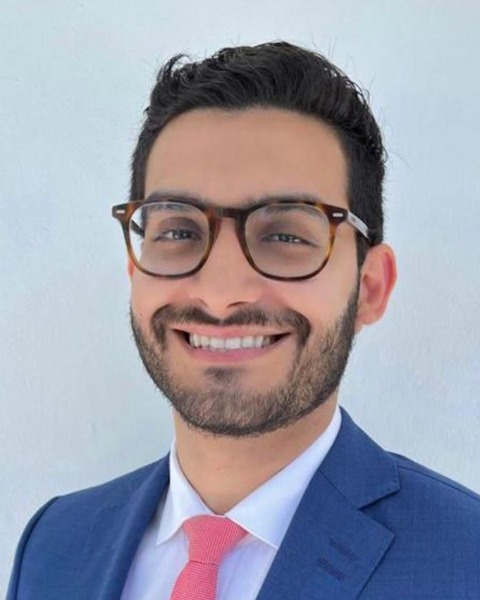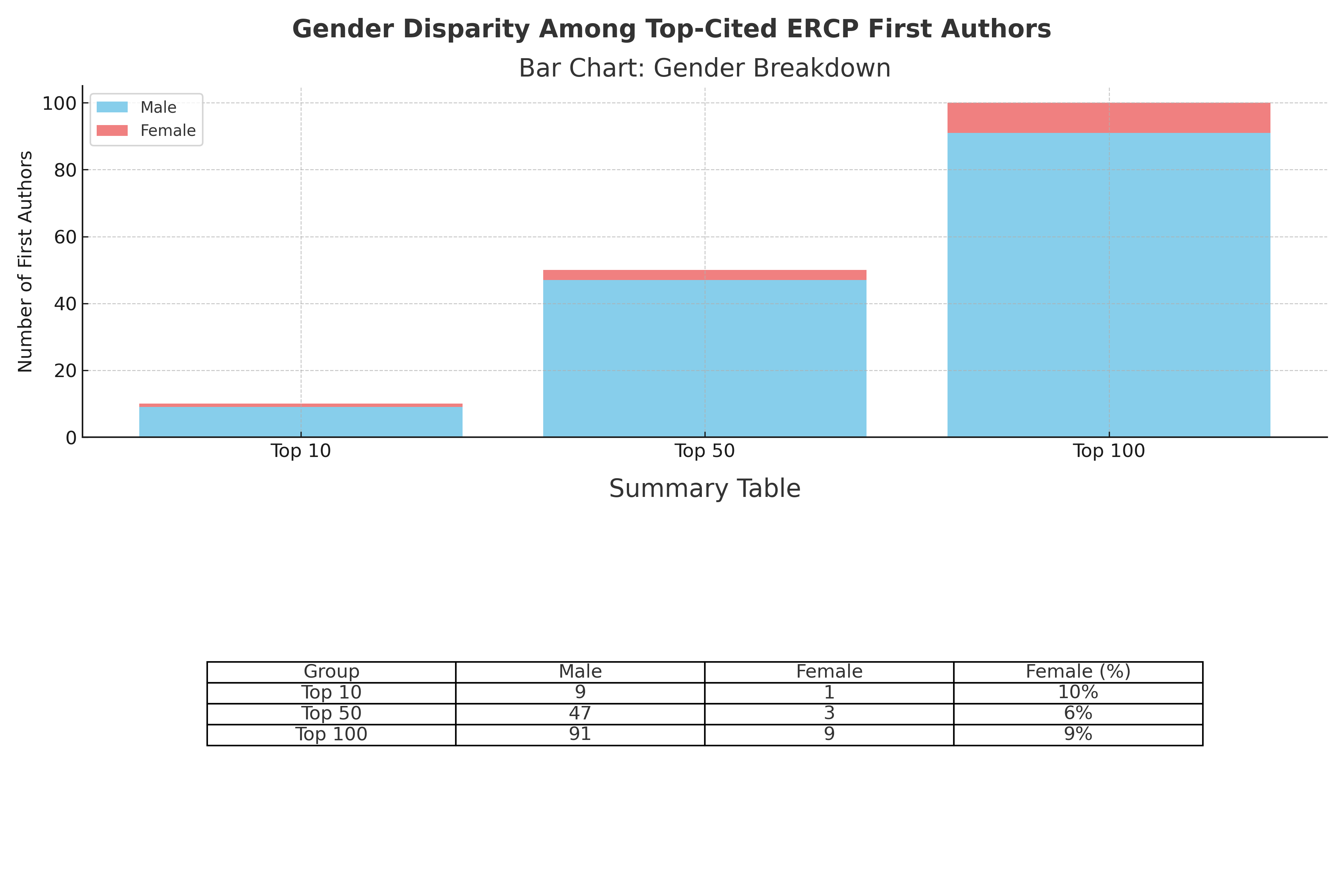Sunday Poster Session
Category: Interventional Endoscopy
P1387 - Dominated by Disparities: Sex and Geographic Inequities in ERCP Research and the Need for Equitable Advancement
Sunday, October 26, 2025
3:30 PM - 7:00 PM PDT
Location: Exhibit Hall

Renan Prado, MD
Cleveland Clinic Foundation
Cleveland, OH
Presenting Author(s)
Renan Prado, MD1, Arjun Chatterjee, MD2, Zehra Naseem, MD1, Leandro Sierra, MD3, Mohamad Mahdi Osman, DO4, Michael Cymbal, DO1
1Cleveland Clinic Foundation, Cleveland, OH; 2Gastroenterology and Hepatology, Cleveland Clinic, Cleveland, OH; 3Department of Internal Medicine, Cleveland Clinic, Cleveland, OH; 4Cleveland Clinic, Cleveland, OH
Introduction: Endoscopic Retrograde Cholangiopancreatography (ERCP) has been pivotal in diagnosing and managing biliary and pancreatic disorders. While ERCP-related research has grown over the past two decades, marked disparities persist in both geographic representation and gender equity. For example, in the 2023 Advanced Endoscopy Fellowship (AEF) match in the United States, only 16% of fellows were women, underscoring a persistent gender gap in interventional endoscopy—a field long dominated by men.
Methods: We conducted a bibliometric analysis using the Web of Science Core Collection, including ERCP-related articles published between January 2000 and March 2025. Bibliometric indicators and collaboration metrics were computed using the Bibliometrix R package.
Results: A total of 5,162 ERCP-related articles were published across 622 journals. The annual growth rate remained stable until 2019, when a noticeable increase in publication output emerged. Leading journals included Gastrointestinal Endoscopy (667 articles) and Endoscopy (448). The United States led in publication volume (1,348 corresponding-author articles) and total citations (33,291), followed by China, Japan, Italy, and Korea. Italy had the highest average citations per article (29.0).
Gender analysis revealed that female first authors remain severely underrepresented in high-impact ERCP literature. Among the top 50 most-cited articles, only 3 (6%) were led by women. In the top 100, just 9 (9%) of first authors were female, compared to 91 male first authors (91%).
Geographic disparity was equally pronounced. In the top 100 most-cited studies, 60% of first authors were based in the United States, compared to 40% from other countries Among the top 50, 66% were U.S.-based. This imbalance reflects both academic centralization and limited high-impact output from low- and middle-income countries, despite growing global ERCP demand.
Discussion: ERCP research remains heavily concentrated in high-income regions and dominated by male authorship, reflecting structural inequities in opportunity and recognition. Our analysis underscores the urgent need for targeted strategies to promote gender equity and amplify contributions from underrepresented regions. In a field where diversity is essential for innovation, equitable access to academic authorship and mentorship must be prioritized to shape the future of interventional endoscopy.

Figure: Gender Disparity Among Top-Cited ERCP First Authors

Figure: Publications by Year and Country
Disclosures:
Renan Prado indicated no relevant financial relationships.
Arjun Chatterjee indicated no relevant financial relationships.
Zehra Naseem indicated no relevant financial relationships.
Leandro Sierra indicated no relevant financial relationships.
Mohamad Mahdi Osman indicated no relevant financial relationships.
Michael Cymbal indicated no relevant financial relationships.
Renan Prado, MD1, Arjun Chatterjee, MD2, Zehra Naseem, MD1, Leandro Sierra, MD3, Mohamad Mahdi Osman, DO4, Michael Cymbal, DO1. P1387 - Dominated by Disparities: Sex and Geographic Inequities in ERCP Research and the Need for Equitable Advancement, ACG 2025 Annual Scientific Meeting Abstracts. Phoenix, AZ: American College of Gastroenterology.
1Cleveland Clinic Foundation, Cleveland, OH; 2Gastroenterology and Hepatology, Cleveland Clinic, Cleveland, OH; 3Department of Internal Medicine, Cleveland Clinic, Cleveland, OH; 4Cleveland Clinic, Cleveland, OH
Introduction: Endoscopic Retrograde Cholangiopancreatography (ERCP) has been pivotal in diagnosing and managing biliary and pancreatic disorders. While ERCP-related research has grown over the past two decades, marked disparities persist in both geographic representation and gender equity. For example, in the 2023 Advanced Endoscopy Fellowship (AEF) match in the United States, only 16% of fellows were women, underscoring a persistent gender gap in interventional endoscopy—a field long dominated by men.
Methods: We conducted a bibliometric analysis using the Web of Science Core Collection, including ERCP-related articles published between January 2000 and March 2025. Bibliometric indicators and collaboration metrics were computed using the Bibliometrix R package.
Results: A total of 5,162 ERCP-related articles were published across 622 journals. The annual growth rate remained stable until 2019, when a noticeable increase in publication output emerged. Leading journals included Gastrointestinal Endoscopy (667 articles) and Endoscopy (448). The United States led in publication volume (1,348 corresponding-author articles) and total citations (33,291), followed by China, Japan, Italy, and Korea. Italy had the highest average citations per article (29.0).
Gender analysis revealed that female first authors remain severely underrepresented in high-impact ERCP literature. Among the top 50 most-cited articles, only 3 (6%) were led by women. In the top 100, just 9 (9%) of first authors were female, compared to 91 male first authors (91%).
Geographic disparity was equally pronounced. In the top 100 most-cited studies, 60% of first authors were based in the United States, compared to 40% from other countries Among the top 50, 66% were U.S.-based. This imbalance reflects both academic centralization and limited high-impact output from low- and middle-income countries, despite growing global ERCP demand.
Discussion: ERCP research remains heavily concentrated in high-income regions and dominated by male authorship, reflecting structural inequities in opportunity and recognition. Our analysis underscores the urgent need for targeted strategies to promote gender equity and amplify contributions from underrepresented regions. In a field where diversity is essential for innovation, equitable access to academic authorship and mentorship must be prioritized to shape the future of interventional endoscopy.

Figure: Gender Disparity Among Top-Cited ERCP First Authors

Figure: Publications by Year and Country
Disclosures:
Renan Prado indicated no relevant financial relationships.
Arjun Chatterjee indicated no relevant financial relationships.
Zehra Naseem indicated no relevant financial relationships.
Leandro Sierra indicated no relevant financial relationships.
Mohamad Mahdi Osman indicated no relevant financial relationships.
Michael Cymbal indicated no relevant financial relationships.
Renan Prado, MD1, Arjun Chatterjee, MD2, Zehra Naseem, MD1, Leandro Sierra, MD3, Mohamad Mahdi Osman, DO4, Michael Cymbal, DO1. P1387 - Dominated by Disparities: Sex and Geographic Inequities in ERCP Research and the Need for Equitable Advancement, ACG 2025 Annual Scientific Meeting Abstracts. Phoenix, AZ: American College of Gastroenterology.
